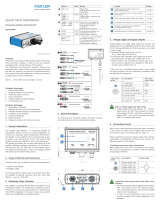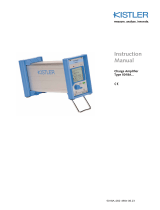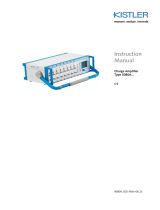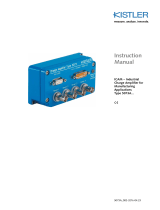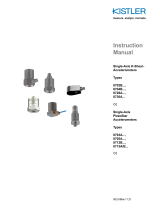Page is loading ...

Instruction
Manual
Signal Conditioning
Platform (SCP)
Type 2853A...
SCP Compact
Type 2854A...
SCP Slim
Type 2852A...
for Engine Indication
ä
2853A_002-291e-08.17


Foreword
2853A_002-291e-08.17 Page 1
Foreword
Thank you for choosing a Kistler quality product
characterized by technical innovation, precision and long
life.
Information in this document is subject to change without
notice. Kistler reserves the right to change or improve its
products and make changes in the content without
obligation to notify any person or organization of such
changes or improvements.
©2004 … 2016 Kistler Group. All rights reserved. Except as
expressly provided herein, no part of this manual may be
reproduced for any purpose without the express prior
written consent of Kistler Group.
Kistler Group
Eulachstrasse 22
8408 Winterthur
Switzerland
Tel. +41 52 224 11 11
Fax +41 52 224 14 14
info@kistler.com
www.kistler.com

Signal Conditioning Platform (SCP)
Page 2 2853A_002-291e-08.17
Content
1. Introduction .................................................................................................................................... 6
2. Safety Notes .................................................................................................................................... 7
2.1 For Your Safety .............................................................................................. 7
2.2 Notes Concerning the Product ........................................................................... 8
2.3 Electromagnetic Compatibility ........................................................................... 9
2.4 Hints on the Use of these Operating Instructions ................................................... 11
2.5 Disposal Instructions for Electrical and Electronic Equipment ..................................... 11
3. Basic Concepts .............................................................................................................................. 12
3.1 Arrangement of SCP Measuring System for Engine Indication on Test Stand ................12
3.2 Arrangement of SCP Compact and SCP Slim Measuring System for Mobile Engine
Indication in Vehicle .......................................................................................13
13
13
3.3 Characteristics of the Signal Conditioning Platform ................................................14
3.3.1 SCP Installation Close to the Sensor ...................................................................14
3.3.2 Drift Compensation of the Piezoelectric Amplifier ..................................................15
3.3.2.1 Drift Compensation of Piezoelectric Amplifier Type 5064C... ................................. 17
3.3.3 PiezoSmart® Automatic Sensor Identification ........................................................18
3.3.4 Automatic Operating Data Acquisition – Updating for Piezoelectric Sensors ................ 20
3.3.5 Automatic Zero Point Correction (Autozero)/Needle Lift Amplifier Type 5247 ..............21
3.4 Definitions of the pMax module Type 5269/5269Y51 ........................................... 22
3.4.1 pmax value ................................................................................................. 22
3.4.2 Three Methods Levels for inlet Pressure Correction ............................................... 22
3.4.3 Thresholds .................................................................................................. 23
4. Installation and Startup ................................................................................................................. 24
4.1 In General .................................................................................................. 24
4.2 pMax module Type 5269/5269Y51 – Scope and Infrastructure ................................ 25
4.3 pMax Module – Brief Operating Instructions ....................................................... 27
4.3.1 SCP Type 2853A... for Monitoring a Maximum of 6 or 8 Channels Respectively ........... 27
4.3.1.1 Diagram of SCP Test Setup .......................................................................... 27
4.3.1.2 Infrastructure Required for SCP (incl. pInlet Measurement) ................................... 27
4.3.1.3 SCP Procedure/Check List ............................................................................ 28
4.3.2 SCP Compact for Monitoring a Maximum of 4 or 6 Channels Respectively ................. 29
4.3.2.1 SCP Compact Diagram and Test Setup SCP Compact (19"-Rack Version, 6 Slots) ....... 29
4.3.2.2 Infrastructure Required for SCP Compact (incl. pInlet Measurement) ....................... 29
4.3.2.3 SCP Compact Procedure/Check List ................................................................ 30
4.3.3 SCP Slim for Monitoring a Maximum of 6 or 8 Channels Respectively.........................31
4.3.3.1 SCP Slim Diagram and Test Setup ................................................................... 31
4.3.3.2 Infrastructure Required for SCP Slim (incl. pInlet Measurement) ............................. 31
4.3.3.3 SCP Slim/Check List Procedure ...................................................................... 32
5. The Signal Conditioning Platform (SCP) ....................................................................................... 33
5.1 The SCP Base Unit Type 2853A... ..................................................................... 34

Introduction
2853A_002-291e-08.17 Page 3
5.2 The SCP Compact Type 2854A... ......................................................................36
5.3 The SCP Slim Type 2852A... ............................................................................38
5.4 Base Unit – the SCP without Measuring Modules ................................................. 40
5.4.1 Connecting the DC-Power Supply for Type 2852A..., Y48 and 2854A... .................... 40
5.4.2 Interface Type 5615 ...................................................................................... 41
5.4.3 Analog Output Type 5225A1 ...........................................................................46
5.5 Amplifier Modules .........................................................................................47
5.5.1 Piezoresistive Amplifier Type 4665/4665Y51 .......................................................47
5.5.2 Charge Amplifier without Sensor Identification Type 5064C11/5064C21 ....................49
5.5.3 Charge Amplifier with Sensor Identification Type 5064C12/5064C13/ 5064C22
/5064C23 ................................................................................................... 51
5.5.4 Voltage Amplifier Type 5227A1Q01 ..................................................................53
5.5.5 Needle Lift Amplifier Type 5247 .......................................................................54
5.5.6 Amplifier Interface Type 5613A1Q01 .................................................................56
5.5.7 Bridge Amplifier Type 5271/5271Y51 ................................................................57
5.6 pMax Module – Hardware and Connections ........................................................59
5.6.1 Optional Supplementary Circuits .......................................................................62
5.7 pMax Module – Functionality ..........................................................................64
5.7.1 Overview of the Measuring Method ..................................................................64
5.7.2 Detailed Information on the Measuring Method (Timing Diagram) ............................66
5.7.3 Stop Signal Actuation .....................................................................................69
5.8 Signal Transmission between Individual Modules via BNC or Backplane ......................... 70
6. Setting the Measuring Module Parameters with the SCP Software .............................................. 72
6.1 Installing the SCP Configuration Software ...........................................................72
6.2 Program Start...............................................................................................73
6.2.1 Problems with Program Start ...........................................................................73
6.2.2 SCP Control Window .....................................................................................74
6.2.3 System Menu ...............................................................................................76
6.3 Setting the SCP Parameters ............................................................................. 81
6.4 Setting Measuring Module Parameters ...............................................................82
6.4.1 Setting the Parameters of the Piezoresistive Amplifier Type 4665 / 4665Y51 ...............83
6.4.2 Setting the Parameters of the Piezoelectric Amplifier Type 5064C… ..........................87
6.4.3 Setting the Parameters of Voltage Amplifier Type 5227A1Q01 .................................89
6.4.4 Setting the Parameters of Needle Lift Amplifier Type 5247 ..................................... 90
6.4.5 Setting the Parameters of the Amplifier Interface Type 5613A1Q01 ..........................92
6.4.6 Setting the Parameters of the Bridge Amplifier Type 5271/5271Y51 ..........................93
6.5 pMax Module Type 5269/5269Y51 Software and Parameter Setting .........................95
7. Changing the Data in the Sensor Data Carrier (TEDS) ................................................................ 101
7.1 Data Structure of the TEDS ............................................................................ 102
7.2 Entering the "Calibration" Access Authorization ................................................. 103
7.3 TEDS for Piezoelectric Sensors ........................................................................ 104
7.3.1 TEDS Configuration for Charge Amplifier Type 5064C... ....................................... 104
7.3.1.1 TEDS Communication with TEDS Couplings without Date Code or with Date Code
Older than 42/07 ..................................................................................... 104
7.3.1.2 TEDS Communication with TEDS Couplings with Date Code from 42/07 ................ 104
7.3.2 The "Initial Calibration Values" Area ................................................................ 105
7.3.3 The "Recalibration Values" Area ..................................................................... 107

Signal Conditioning Platform (SCP)
Page 4 2853A_002-291e-08.17
7.3.4 "Working Time and Cycles" Section................................................................. 110
7.3.5 The "User Text" Area .................................................................................... 111
7.3.6 Entering Recalibration Values .......................................................................... 111
7.4 TEDS for Piezoresistive Sensors ....................................................................... 112
7.4.1 The "Initial Calibration Values" Area ................................................................ 112
7.4.2 The "Recalibration Values" Area ..................................................................... 114
7.4.3 The "User Text" Area ................................................................................... 115
7.4.4 Entering Recalibration Values ......................................................................... 116
8. Technical Data ............................................................................................................................ 117
8.1 The SCP Base Unit Type 2853A... .................................................................... 117
8.2 The SCP Compact Type 2854A... .................................................................... 121
8.3 The SCP Slim Type 2852A... ........................................................................... 123
8.4 Technical Data for all Modules ........................................................................ 125
8.5 Piezoresistive Amplifier Type 4665/4665Y51 ...................................................... 126
8.6 Charge Amplifier without Sensor Identification Type 5064C… ................................ 128
8.7 Voltage Amplifier Type 5227A1Q01 ................................................................ 130
8.9 Needle Lift Amplifier Type 5247 ...................................................................... 132
8.10 Amplifier Interface Type 5613A1Q01 ............................................................... 134
8.11 Bridge Amplifier Type 5271/5271Y51............................................................... 135
8.12 SCP Software ............................................................................................. 137
8.13 pMax Module ............................................................................................ 137
8.13.1 Characteristics and Measurands ...................................................................... 137
8.13.2 Block Schematic Diagram .............................................................................. 139
9. Glossary ...................................................................................................................................... 140
10. SCP Event Log ............................................................................................................................. 144
10.1 Description and Format of the Event Messages ................................................... 144
10.2 Overview of Event Messages .......................................................................... 144
10.3 Description of the Event Messages ................................................................... 146
10.3.1 Event Code 4 – Charge Amplifier Overload ........................................................ 146
10.3.2 Event Code 6 – Input Offset Out of Range ........................................................ 146
10.3.3 Event Code 7 – Wrong Calibration Data ............................................................ 147
10.3.4 Event Code 8 – Remote Measure .................................................................... 147
10.3.5 Event Code 12 – TEDS Received Invalid Data from ID Chip .................................... 147
10.3.6 Event Code 13 – TEDS Received Invalid Sensitivity ............................................... 148
10.3.7 Event Code 14 – Wrong MID data ................................................................... 148
10.3.8 Event Code 15 – System Power-Up .................................................................. 148
10.3.9 Event Code 17 – TEDS Template not Supported or Data Corrupt ............................. 149
10.3.10 Event Code 20 – Output Overload................................................................... 149
10.3.11 Event Code 21 – Polarity Setting Changed ......................................................... 150
10.3.12 Event Code 39 – Sensor Connection ................................................................. 150
10.3.13 Event Code 40 – TEDS Sensor Available ............................................................ 151
10.3.14 Event Code 43 – TEDS Bouncing ..................................................................... 151
10.3.15 Event Code 79 – Engine Stop ......................................................................... 151
10.3.16 Event Code 80 – pMax ................................................................................. 152
10.3.17 Event Code 201 – Aurorange ......................................................................... 152
10.4 Charge Amplifier ......................................................................................... 153

Introduction
2853A_002-291e-08.17 Page 5
10.5 Piezoresistive Amplifier ................................................................................. 153
11. Declaration of Conformity Type 2853A... ................................................................................... 154
12. Declaration of Conformity Type 2854A.../2865B... .................................................................... 156
13. Declaration of Conformity Type 2852A… .................................................................................. 158
Total pages: 155

Signal Conditioning Platform (SCP)
Page 6 2853A_002-291e-08.17
1. Introduction
Please take the time to thoroughly read this instruction
manual. It will help you with the installation, maintenance,
and use of this product.
To the extent permitted by law Kistler does not accept any
liability if this instruction manual is not followed or
products other than those listed under Accessories are
used.
Kistler offers a wide range of products for use in measuring
technology:
Piezoelectric sensors for measuring force, torque, strain,
pressure, acceleration, shock, vibration and acoustic-
emission
Strain gage sensor systems for measuring force and
torque
Piezoresistive pressure sensors and transmitters
Signal conditioners, indicators and calibrators
Electronic control and monitoring systems as well as
software for specific measurement applications
Data transmission modules (telemetry)
Kistler also develops and produces measuring solutions for
the application fields engines, vehicles, manufacturing,
plastics and biomechanics sectors.
Our product and application brochures will provide you
with an overview of our product range. Detailed data
sheets are available for almost all products.
If you need additional help beyond what can be found
either on-line or in this manual, please contact Kistler's
extensive support organization.

Safety Notes
2853A_002-291e-08.17 Page 7
2. Safety Notes
It is essential for you to study the following notes; they are
for your personal safety during work with the Signal
Conditioning Platform (SCP) and to ensure long term,
fault-free operation of this unit.
2.1 For Your Safety
This product has been manufactured in compliance with
the currently valid safety regulations. It meets all relevant
regulations according to the attached conformity declara-
tion. It has left the factory in a perfectly safe condition. In
order to maintain this condition and ensure safe operation,
compliance is required with the instructions and warning
notes contained in these Operating Instructions or imprin-
ted on the product.
Please also comply with the local safety regulations concer-
ning the handling of electrical and electronic equipment.
If it is to be assumed that safe operation is no longer
possible, the equipment must be shut down and made safe
against being accidentally started up.
Safe operation is no longer possible when the product
shows visible signs of damage
is no longer operating
has been in lengthy storage under unsuitable conditions
has been subjected to rough transport conditions.
If safe operation can no longer be guaranteed, the product
must be returned immediately to the manufacturers or to
the authorized distributor for repair.
Whenever the product is connected to the power supply,
live parts can be exposed if covers are opened or if parts
are removed – except when this is possible by hand.
Adjustment, maintenance and repair work on exposed, live
parts must be avoided as far as possible. If, however, such
work is unavoidable, it must be undertaken only by a
skilled person who is familiar with the dangers involved.

Signal Conditioning Platform (SCP)
Page 8 2853A_002-291e-08.17
2.2 Notes Concerning the Product
Check all packaging for visible transport damage. Report
any such damage to the transporters and to the authorized
Kistler distributor/sales outlet.
Please check the scope of delivery before first use of the
equipment. Report any missing parts to the authorized
Kistler distributor/sales outlet.
Carry out the following safety precautions if the product is
to be transported or stored for a lengthy period of time:
Cover all BNC, Fischer and triax connections with the
dust caps supplied.
Make sure that no dirt can enter the product.
The environment should be as dry and free from
vibrations as possible.
Place the product so that neither its front nor rear side
can be subjected to pressure.
If possible, store the product in its original packaging.
Comply with the requirements for ambient temperature for
storage and operation as stated in the technical data. If, for
example, the ambient temperature is exceeded to a
significant extent, this can permanently damage the
product.
Protect the inputs and outputs of the product against
contamination. Keep the plug-and-socket connections
clean and dry. Fit the cap supplied when a connector is not
being used.
The piezoelectric sensor and the coaxial cable connected to
it have extraordinarily high insulation values. As a result,
when an amplifier is not connected, a high voltage due to
a static charge can occur. In order to avoid damage when
connecting the amplifier, you can short-circuit the cable
directly in front of the connection with a suitable instru-
ment (such as a BNC short-circuiting cover neg., Kistler
Type 1865).
Carry out work with the product only under the specified
operating conditions. Protect the SCP against dust and
mechanical stress such as shock and vibration. Avoid high
atmospheric humidity and changes in temperature which
could lead to condensation.

Safety Notes
2853A_002-291e-08.17 Page 9
Any interruption to the equipment grounding conductor
inside or outside the equipment, or disconnection of the
grounding conductor connection represent a danger to
you and the product. Intentional disconnection is not
permitted.
The power connector must only be connected to a
socket outlet which has a grounding contact. This
protection must not be removed by an extension cable
with no grounding connection.
Blown fuses must be replaced with the appropriate types
with the specified current rating. The use of "repaired"
fuses or short-
circuiting of the fuse holder is not
permitted.
The lug on the terminal at the rear panel is connected to
the power connector ground and can be used to
connect an common grounding conductor.
2.3 Electromagnetic Compatibility
The Signal Conditioning Platform has CE conformity. The
product meets the safety requirements of EN 61010-1 as
well as the requirements for electromagnetic compatibility
according to EN 61006-6-3/4 (interference emission) and
EN 61000-6-1/2 (interference immunity).
To ensure that electromagnetic compatibility (EMC) is
maintained for the entire measuring chain, particular care
must be given to connection of the inputs and outputs of
the cable screen and to the cable installation:
Do not install the cable in parallel with interfering con-
ductors.
Use only screened cables.
Ensure good connection between screen, connector case
and equipment case.
Comply with EMC standards also on the machine side.

Signal Conditioning Platform (SCP)
Page 10 2853A_002-291e-08.17
EMC and Ground Loops
Piezoelectric sensors are normally designed, so that one of
the electrodes is on the sensor case. When it is installed,
the sensor is usually grounded by the metal structure
(safety). The amplifier has separated input grounds of
channel A und channel B in order to prevent signal
interference. A differential amplifier stage prevent ground
loops between any input ground and the output ground.
Fig. 1: Front view of charga amplifier Type 5064C21
Signal output
channel A channel B
Signal input
channel A channel B

Safety Notes
2853A_002-291e-08.17 Page 11
2.4 Hints on the Use of these Operating Instructions
These instructions describe the Signal Conditioning
Platform for engine indication Type 2852A..., 2853A... and
2854A... with the various measuring modules and the
associated configuration software.
We recommend you to read the entire operating instruc-
tions carefully. However, if you are in a hurry and already
have experience with Kistler products, you can confine
yourself to reading the specific information needed.
We have attempted to give these instructions a clear
presentation to make it easier for you to gain direct access
to the information you need. Please keep these operating
instructions in a safe place where you can retrieve them at
any time.
If you lose these operating instructions, please contact your
Kistler distributors/sales outlet and ask them for an
immediate replacement.
All details and information in these instructions may be
changed as a result of technical progress at any time
without prior notification.
Equipment modifications (conversions, upgrades etc.)
usually also result in amendments to the operating instruc-
tions. In this case, contact your Kistler Customer Service for
an update.
From now on all of the models of the platform will be
simply designated "SCP". However, where reference is
made to a special type, the full name will be given.
2.5 Disposal Instructions for Electrical and Electronic Equipment
Do not discard old electronic instruments in municipal
trash. For disposal at
end of life, please return this
product to an authorized local electronic waste disposal
service or contact the nearest Kistler Instrument sales
office for return instructions.

Signal Conditioning Platform (SCP)
Page 12 2853A_002-291e-08.17
3. Basic Concepts
3.1 Arrangement of SCP Measuring System for Engine Indication on
Test Stand
The measuring signals of the piezoelectric and piezoresis-
tive pressure sensors installed in the test engine are
transmitted by cable to the relevant amplifier modules of
the Signal Conditioning Platform. These convert the signals
to a voltage which is amplified to a standardized voltage
signal (±10 V). In a typical application, this voltage signal is
then further processed by a data acquisition unit.
To achieve maximum signal quality, the measuring signals
are conditioned in the SCP on a purely analog basis. Digital
signals are used only for setting parameters and to actuate
the measuring modules.
The individual SCP measuring modules have their para-
meters set or are actuated via a PC or a higher ranking
computer (Host) via an RS-232C interface.
Fig. 2: Measuring system arrangement on engine test
stand

Basic Concepts
2853A_002-291e-08.17 Page 13
3.2 Arrangement of SCP Compact and SCP Slim Measuring System for
Mobile Engine Indication in Vehicle
The SCP Compact 2854A131 and the SCP Slim 2852A11
are designed specifically for mobile measurements, for
example in vehicles. In addition to their compactness these
versions of the SCP are differentiated by a (10 ... 36 VDC)
power supply.
Fig. 3: Arrangement of SCP Compact and SCP Slim measuring system
Fig. 4: Arrangement of mobile measuring system in vehicle
Communication in both directions
with TEDS for automatic identification
of pressure sensors
RS-232C
analog signals
SCP Compact 2854A131
RS-232C
SCP Slim 2852A11

Signal Conditioning Platform (SCP)
Page 14 2853A_002-291e-08.17
3.3 Characteristics of the Signal Conditioning Platform
Special features and functions ensure that the SCP provides
the most accurate and reliable measuring results possible,
see following description.
3.3.1 SCP Installation Close to the Sensor
In order to minimize measuring errors due to interference
and the resulting parasitic charge transfers or interference
currents, the connecting cable between sensor and ampli-
fier input should be kept as short as possible. The SCP is
designed so that it can be installed and operated in the
immediate vicinity of the engine in the test stand cubicle.
All settings can be remote controlled from a PC with the
SCP software or from a higher ranking computer (Host).
Fig. 5: SCP installed close to the sensor
Use only low-noise cable between piezoelectric sensors
and the associated charge amplifiers. This is the only
way to ensure that noise is kept to an acceptable level.
The cables offered by Kistler provide optimized trans-
mission and signal quality, and guarantee precise signal
transfer.

Basic Concepts
2853A_002-291e-08.17 Page 15
3.3.2 Drift Compensation of the Piezoelectric Amplifier
Thermal charge transfers in the measuring element and
leakage current in the incoming leads and in the amplifier
lead to a gradual change in the measured value. This
change is called drift and, particularly if the load on the
engine changes or if uncooled sensors are being used.
During prolonged measurement this drift can lead to the
measured signal falling outside the charge amplifier's
output range of ±10 V.
This effect is largely eliminated electronically with specially
developed drift compensation. This allows measurement to be
performed for any length of time, even during engine
transients.
In its effect, drift compensation is comparable with high-
pass filter. However, switching drift compensation on does
not lead to pMax or PMI errors at excessively low speeds
as with the high-pass filter, as the function only
compensates for the drift and not the actual engine
pressure signals. For further details see capt. 3.3.2.1.
Fig. 6: Pressure measurement with and without drift compensation
Fig. 6 shows that with a compensated engine signal the
reference line remains on zero, compared to an
uncompensated signal that drifts in a negative direction.
No Drift with drift
compensation
Drift without drift
compensation
0
2
p [bar]
t [sec]

Signal Conditioning Platform (SCP)
Page 16 2853A_002-291e-08.17
Example: Drift with a Change in Load During Measure-
ment with Uncooled Sensor
When there is a change of load in the engine between
when the engine is in fired mode and when it is in unfired
mode, the combustion temperature changes. Fig. 7 shows
a measured curve with no drift compensation applied. The
signal drifts considerably.
Fig. 7: Measured curve without drift compensation
With drift compensation operating (Fig. 8), the measuring
signal does not drift. The rapid rise at the beginning of the
engine in unfired mode is recognized an erroneous signal
and compensated for after a delay.
Fig. 8: Measured curve with drift compensation
0
100
unfired mode
fired mode
fired mode
0
100
unfired mode
fired mode
fired mode
t [sec]
t [sec]
p [bar]
p [bar]

Basic Concepts
2853A_002-291e-08.17 Page 17
3.3.2.1 Drift Compensation of Piezoelectric Amplifier Type 5064C...
The Type 5064C... eliminates the drift of a cylinder
pressure signal with a digital drift compensation function.
The signal from the charge amplifier is acquired digitally for
this purpose. The microprocessor calculates the drift over
recent cycles and extrapolates its trend. This anticipated
drift is then fed back into the input of the charge amplifier
as reverse current. This avoids falsifying either the phasing
or the amplitude curve of the cylinder pressure signal.
Correct indication values can be calculated from the signals
of the charge amplifier.
Digital drift compensation is applied in the speed range
from 100 … 20 000 1/min.
If drift compensation is not possible or if no combustion
cycles are detected, the module automatically switches the
charge amplifier stage to the “Short” or “Long” mode.
This is indicated by the fast flashing yellow LED in
Drco/Short mode and by a slow flashing yellow LED in
Drco/Long mode. The amplifier switches back to drift
compensation automatically when a combustion cycle is
detected.
For measuring cylinder pressure signals the amplifier can
always be operated with drift compensation switched on.
However, drift compensation cannot be applied to other
signals.
Drco on/off
uC
A
D A
D
Output
Input

Signal Conditioning Platform (SCP)
Page 18 2853A_002-291e-08.17
3.3.3 PiezoSmart® Automatic Sensor Identification
PiezoSmart automatic sensor identification is an active
system for identifying individual piezoelectric and piezo-
resistive pressure sensors and accelerometers. Based on the
IEEE 1451.4 standard, this system offers Plug & Measure
capability for automatic parametrization of measuring
chains.
Fig. 9: Sensors wth sensor identification and charge
amplifier
The heart of PiezoSmart is an electronic medium known as
TEDS (Transducer Electronic Data Sheet) integrated into
the plug of the sensor cable on the amplifier side. This
TRIAX plug and the pressure sensor together constitute a
physical unit. The size and shape of the TRIAX plug fits the
standard Kistler mounting tool for M5 miniature sensors.
As the plug with the TEDS does not need to be separated
from the sensor when the sensor is installed, clear and
unequivocal allocation of sensor data is ensured in daily
test stand operation.
/

